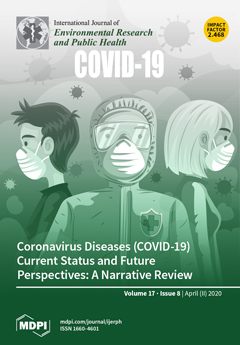Ambient particulate matter (PM), a major component of air pollution, aggravates ocular discomfort and inflammation, similarly to dry eye disease (DED) or allergies. However, the mechanism(s) by which PM induces the ocular inflammatory response is unknown. This study investigated the immunological response of
[...] Read more.
Ambient particulate matter (PM), a major component of air pollution, aggravates ocular discomfort and inflammation, similarly to dry eye disease (DED) or allergies. However, the mechanism(s) by which PM induces the ocular inflammatory response is unknown. This study investigated the immunological response of traffic-related fine particulate matter (PM
2.5) on the ocular surface in a murine model. C57BL/6 mice were exposed by topical application to PM
2.5 or vehicle for 14 days to induce experimental environmental ocular disease. Corneal fluorescein staining and the number of ocular inflammatory cells were assessed in both groups. The expression of IL-1β, IL-6, tumor necrosis factor (TNF)-α, and mucin 5AC (MUC5AC) in the ocular surface were evaluated by real-time PCR. An immunohistochemical assay evaluated apoptosis and goblet cell density. ELISA was used to determine the levels of serum IgE and cytokines of Type 1 helper (Th1) and Type 2 helper (Th2) cells after in vitro stimulation of T cells in the draining lymph nodes (LNs). Exposure to traffic-related PM
2.5 significantly increased corneal fluorescein staining and cellular toxicity in the corneal epithelium compared with the vehicle control. A significant increase in the number of CD11b+ cells on the central cornea and mast cells in the conjunctiva was observed in the PM
2.5 group. Exposure to PM
2.5 was associated with a significant increase in the corneal or conjunctival expression of IL-1β, IL-6, TNF, and MUC5AC compared to the vehicle, and increased maturation of dendric cells (DCs) (MHC-II
highCD11c
+) in draining LNs. In addition, PM
2.5 exposure increased the level of serum IgE and Th2 cytokine production in draining LNs on day 14. In conclusion, exposure to traffic-related PM
2.5 caused ocular surface damage and inflammation, which induced DC maturation and the Th2-cell-dominant allergic immune response in draining LNs.
Full article





